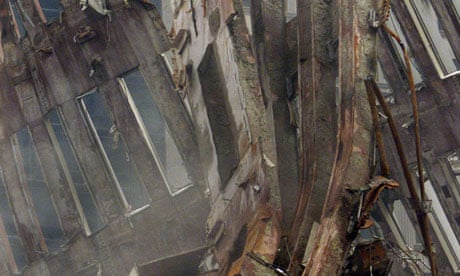An educational charity has shelved plans to erect a sculpture beside the Thames using girders from the World Trade Centre after opposition from British families who lost relatives in the 9/11 attacks.
The artwork by the New York-based artist Miya Ando, which was intended to be a permanent structure, had received planning permission from Southwark council and was to be unveiled in Potters Fields in September, to coincide with the 10th anniversary of the terrorist attacks that destroyed the twin towers.
Ando said she wanted to create "a meditative environment" from the girders.
"The columns will remain in their current, unchanged form, thereby presenting the material in a pure and honest manner," Ando said on the project's website. "It is my hope that by standing upright the fallen steel columns, I may evoke a quiet yet strong message of transcendence, and the role of education in the growth of hope from tragedy. It is my hope that this sculpture will stand as a beacon for the educational programme."
But since hostility to the artwork emerged last month at a meeting organised by Southwark council, during which the historian and adviser to the project Simon Schama made an impassioned plea for Ando's work, plans for the sculpture have been put on hold. Schama said its absence would take away "the possibility of the citizens of London being able to reflect on the mortal danger posed by this atrocity".
An education programme and the artwork lay at the heart of the 9 11 London project, set up to gain "a proper understanding of what happened; and thereby help to reduce the possibilities of any similar act in the future".
The education component, which will go ahead, is being developed by the University of London's Institute of Education under its director, Professor Geoff Whitty. It draws on personal testimonies and explores the legacy of the attacks on international relations and individual lives.
While no one has objected to the project's educational component, the artwork has aroused considerable hostility.
The historian's case seemed to leave many unconvinced, including Hannah Ali, whose sister Sarah died on the 102nd floor of the north tower of the World Trade Centre, and who was dismayed that anyone could think of turning steel that had "bodies strewn on them" into a work of art. "I feel very strongly that the girders should not be used in this way," she told the Guardian. "I find it quite disturbing, the actual design is quite raw and crude and I don't find anything inspirational in it." Ali, a member of the September 11 UK families support group, added: "It is in my interest that that day is not forgotten but I don't believe it should be thrown into people's faces."
The group, which was formed in 2002, also felt the planned artwork would diminish the significance of an existing memorial garden in London's Grosvenor Square, which opened in 2003.
"Does London really need this?" asked Alex Clarke, chairwoman of the UK families support group. "It will be particularly obtrusive at Potters Fields – everywhere you look it will be in your view. We have a piece of the girder buried under Grosvenor Square, that's where it should be."
The choice of Potters Fields between Tower Bridge and the City Hall on the south side of the river, has not gone down well with residents either. The trust that manages the park believes the scale of the installation with its 28ft girders, is too big. But it was the use of the girders themselves that has proved the bigger and more emotional issue.
Given the stong opposition of the British families, the trustees of the project have decided to conduct more consultations on the artwork, which means it will not be in place by September.
"In response to the concerns that have been expressed and in order to ensure that nothing threatens the impact or effectiveness of the launch and development of the education programme we have decided to extend the consultation period regarding the artwork," the project trustees said in a statement. "This means that any decision on the artwork will be deferred until after September and the artwork will play no part in the events relating to the launch of the education programme."
This represents an abrupt change of tack as only a few days ago, the project's organisers insisted that its plans for September were on course.
